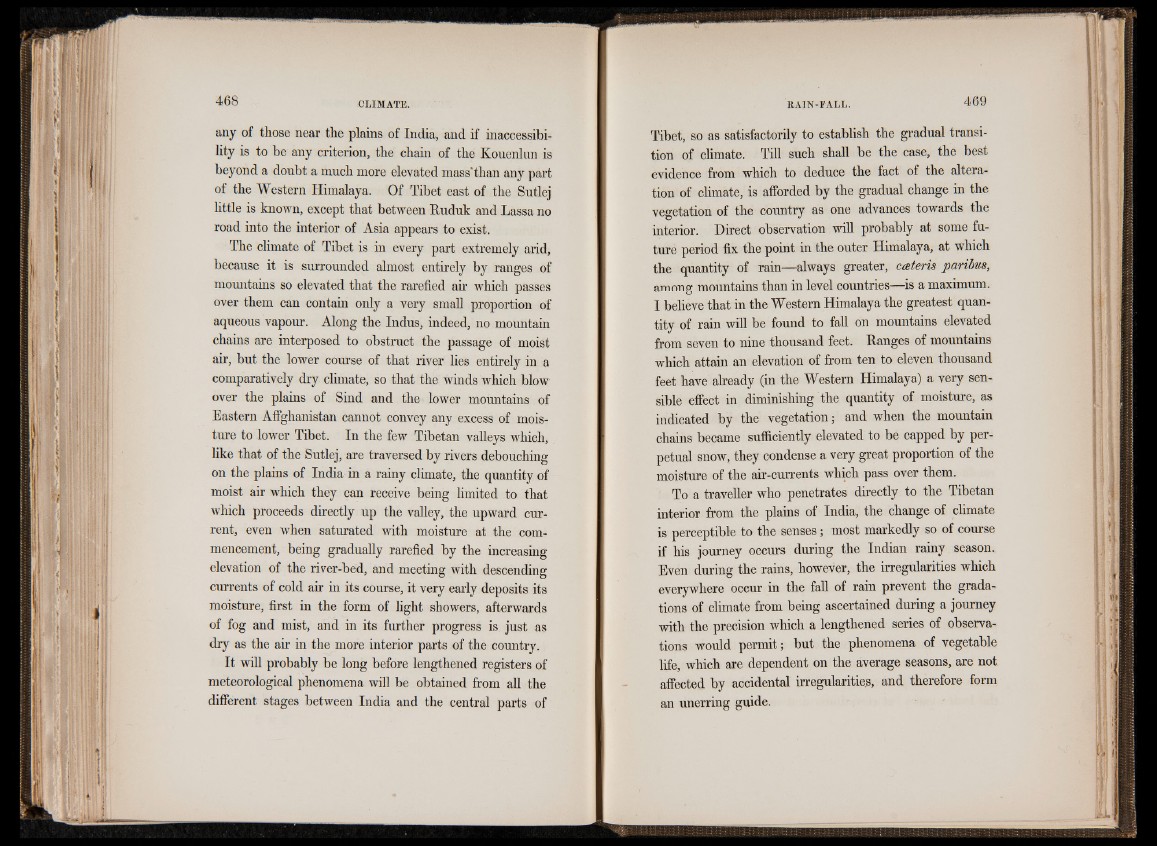
any of those near the plains of India, and if inaccessibility
is to be any criterion, the chain of the Kouenlun is
beyond a doubt a much more elevated mass'than any part
of the Western Himalaya. Of Tibet east of the Sutlej
little is known, except that between Ruduk and Lassa no
road into the interior of Asia appears to exist.
The climate of Tibet is in every part extremely arid,
because it is surrounded almost entirely by ranges of
mountains so elevated that the rarefied air which passes
over them can contain only a very small proportion of
aqueous vapour. Along the Indus, indeed, no mountain
chains are interposed to obstruct the passage of moist
air, but the lower course of that river lies entirely in a
comparatively dry climate, so that the winds which blow
over the plains of Sind and the lower mountains of
Eastern Affghanistan cannot convey any excess of moisture
to lower Tibet. In the few Tibetan valleys which,
like that of the Sutlej, are traversed by rivers debouching
on the plains of India in a rainy climate, the quantity of
moist air which they can receive being limited to that
which proceeds directly up the valley, the upward current,
even when saturated with moisture at the commencement,
being gradually rarefied by the increasing
elevation of the river-bed, and meeting with descending
currents of cold air in its course, it very early deposits its
moisture, first in the form of light showers, afterwards
of fog and mist, and in its further progress is just as
dry as the air in the more interior parts of the country.
It will probably be long before lengthened registers of
meteorological phenomena will be obtained from all the
different stages between India and the central parts of
Tibet, so as satisfactorily to establish the gradual transition
of climate. Till such shall be the case, the best
evidence from which to deduce the fact of the alteration
of climate, is afforded by the gradual change in the
vegetation of the country as one advances towards the
interior. Direct observation will probably at some future
period fix the point in the outer Himalaya, at which
the quantity of rain—always greater, c(Eteris paribus,
among mountains than in level countries—is a maximum.
I believe that in the Western Himalaya the greatest quantity
of rain will be found to fall on mountains elevated
from seven to nine thousand feet. Ranges of mountains
which attain an elevation of from ten to eleven thousand
feet have already (in the Western Himalaya) a very sensible
effect in diminishing the quantity of moisture, as
indicated by the vegetation; and when the mountain
chains became sufficiently elevated to be capped by perpetual
snow, they condense a very great proportion of the
moisture of the air-currents which pass over them.
To a traveller who penetrates directly to the Tibetan
interior from the plains of India, the change of climate
is perceptible to the senses; most markedly so of course
if his journey occurs during the Indian rainy season.
Even during the rains, however, the irregularities which
everywhere occur in the fall of rain prevent the gradations
of climate from being ascertained during a journey
with the precision which a lengthened series of observations
would permit; but the phenomena of vegetable
life, which are dependent on the average seasons, are not
affected by accidental irregularities, and therefore form
an unerring guide.